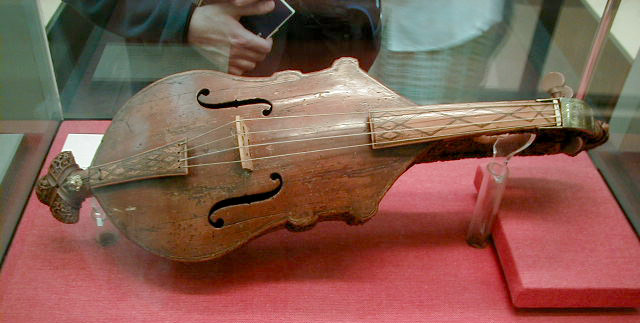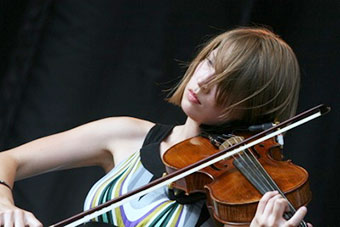The History of the Viola
Although it is believed that the Italian luthier Andrea Amati created the modern violin family around the year 1555, bowed stringed instruments were invented long before this date. For this reason, it can be helpful to think of the viola as an instrument that has evolved over time, rather than as a perfected product that was instantaneously invented.
While there are records of stringed instruments existing in Europe in the Middle Ages, it is thought that the first bowed, stringed instruments may have originated in Central Asia with instruments such as the morin khuur from Mongolia. These Central Asian instruments then travelled via trade routes to other parts of the world. Once instrument craftsmen in Europe became aware of these instruments and how they were made, they then created their own take on them, using traditional European crafting techniques.

Many different kinds of stringed, bowed instruments evolved in the 16th century in Europe, which has caused some contention about certain aspects of the violin family's history. It is thought that perhaps Andrea Amati did not create the first modern violin, and that it was instead created in Brescia earlier in the 16th century. The term 'viola' was definitely used well before the start of the 16th Century to describe a stringed instrument of a similar nature to the 'viola' that we know today. One thing we can be certain about is that there were a wide variety of different stringed instruments around in the 16th century that the modern violin, viola and its family eventually evolved from - including the lira da braccio, a bowed stringed instrument much like the modern viola that was popular in the Renaissance period.
The viola is not very different in range to the violin, as it has only one string that is different. Where the violin is tuned GDAE and has a higher range and a smaller body, the viola is tuned CGDA and has a slightly lower range and a larger body. The range of the violin is seen as being more compatible to bright, brilliant melodies, whereas its sister the viola sometimes plays a counter melody in orchestral compositions - often a third or a fifth underneath the violins melody, or shadows the bass part an octave higher. The viola is celebrated for its intense, melancholic timbre - a feature that has often been overlooked when the tone of the viola is compared to the bright tone of the violin.
There are some notable physical differences in the playing technique of the violin and the viola. As the viola is bigger than the violin, the finger positions are spread further apart, requiring the viola player to have greater technical skill than the violin player when playing the same passage. The viola is often heavier than the violin, and the bow is harder to handle as it is also weightier than a violin bow. The C string is much thicker than any violin string, and so it takes more effort to push down the string to play a note. In fact, the viola is sometimes used for a few months by violinists who want to improve their playing technique, as the viola requires more skill to play!
The viola has rather unfortunately been overshadowed for the entirety of its long life by the violin. The viola has long been seen as a less superior instrument in tone, volume and expression that the violin, and subsequently it has been paid very little attention for the majority of its lifetime. In early orchestras, viola players were often 'failed' violin players - a violinist who did not make first or second violin who would instead play the viola.
The viola has had a comparatively large development period, with few rigid guidelines in place regarding the size and specifications of the instrument. This is because the lower range of the viola requires a larger sound box to create a full tone. The size of the sound box needed to create this full-bodied tone would make the instrument too big to hold under the chin. Consequently, the viola has undergone a lot of changes: including various changes to the size and shape of the soundbox, as well as to the length of the fingerboard as craftsmen have tried to develop the sound, timbre and range of the viola. These evolutions have mainly aimed to make the viola as similar to the violin in sound and style as possible, which may account for why the viola is still played under the chin. Full-size violas can vary in length from around 14-15 inches to over 17 inches.
The Viola Today

Today, the viola is becoming more recognised as having a personality of its own, and an identity separate to that of the violin. Viola makers continue to experiment with different forms for the viola to maximise its unique tonal qualities. It does seem that the viola still has a significant contribution to make to the history and development of music, in spite of its long history of being sorely overlooked.
Violas that are made today can produce sound electronically by using amplifiers and microphones, eliminating the need for a sound box. Fully electric sound produced by violas can also be distorted through amplifier settings to create different tonal qualities altogether - further diversifying the capabilities of this instrument.












Investigator
Hey, you guys gotta stop doing this. Talking fancy about the viola leads to the secret of viola awesomeness getting out and people everywhere are gonna want to play it. Shhhh....
erttttty
thx fr this this helped so much with ma essay
I am the only viola player in the orchestra and I am always being recognised as a violin player
VIVA LA VIOLA
*of, sorry
Have any o u guys heard Santa plays the viola? (hey, at least he doesn't play the violin)
So I’m writing an essay and I would like to know when the first viola was made.
I like the viola better. It's true.
BOBS BUILDIN' a badump hulurolo
This helped when i was bored at night and did't know what to do with my time. I told callie to go to bed. LOL
Booooooo whoever said violas make good firewood!!!!!!!!!! VIOLAS are better than violins!!!!!! Violins just sound like banshees.
Thank you guys so much for doing this article! it helped me so much with my research project!
THANK YOU SO MUCH! This gave me so many useful information. I play the Viola and decided to make it the topic of my research project. All of this was worded beautifully, I literally couldn't have said it myself :)
I play viola. I hope to bring viola’s more popularity someday, because I believe it is a very good instrument many overlook. Though, I know, it’s is very awkward with the strings, there is ways you can surely use the mish mash of the Cello and the Violin to your advantage.
I play viola. I hope to bring viola’s more popularity someday, because I believe it is a very good instrument many overlook. Though, I know, it’s is very awkward with the strings, there is ways you can surely use the mish mash of the Cello and the Violin to your advantage.
When did the viola join the orchestra?
:) :P >:D Info! yea.
Whenever i feel down about my playing I just look up a viola concerto. They make my dying cats screeches sound like Godsent harmonics. uwu
i love violas! they make excellent firewood
GOOD WEBSITE !!!!!!!!!!!!!!!!!!!!!!!!!
GOOD WEBSITE !!!!!!!!!!!!!!!!!!!!!!!!!